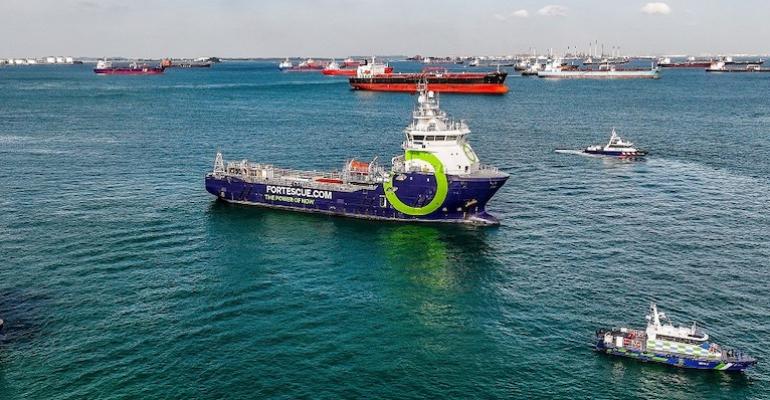One the most noticeable changes attending Singapore Maritime Week from 12 months earlier was how much further ammonia has moved up the agenda as a zero-carbon fuel for the future.
Marcus Hand | Apr 23, 2024
There was far more discussion about ammonia as a serious, maybe even dominant, part of the future fuel mix, but at the same time it was clear safety of both the crew and to the wider environment in the case of an accident with such a highly toxic fuel have not been fully resolved as yet.
The week came against the recent backdrop of trials in Singapore of converted offshore vessel Fortescue Green Pioneer which was moored at Keppel Bay for visiting officials and executives to get an opportunity to see first-hand a vessel retrofitted with an ammonia engine and fuel systems.
Related: Ammonia engines emissions concerns as commercial momentum grows
Among those visitors was International Maritime Organization (IMO) Secretary-General Arsenio Dominguez, who requested to take part in a safety drill to see how long it actually takes put to on the PPE. Dominguez said it took him 2 minutes and 23 seconds, which was slightly longer than the 2 minutes it should take with no experience or practice. “So, it’s doable,” he commented.
However, he also admitted there are concerns and said that the IMO is working on these through the Maritime Just Transition Task Force with the International Chamber of Shipping (ICS), the International Transport Workers’ Federation (ITF), the United Nations Global Compact (UNGC), and the International Labour Organization (ILO), and a number of countries, including Singapore, were carrying out tests.
Related: World first use of ammonia fuel in trial on Fortescue vessel in Singapore
“But we have the same concerns with LNG in the past, and we went through it, we approached it with the necessary care and in the actions that we needed to take. And now we’re not talking about those safety aspects of LNG,” he said at a media briefing.
In terms of training and safety he said, “Those companies that are designing and building these new engines are also working on this because it’s for their benefit that these engines are operated properly. And that’s what we’re working on.”
Japanese shipbuilding and engineering company IHI has already delivered its first ammonia engine for an ammonia-powered tugboat, a project backed by the country’s government.
Speaking at the SMW conference Hiroki Kobayashi, CEO of IHI Asia – Pacific, said they were working towards an ammonia end-to-end supply chain, which was technically speaking “almost there”.
“However, as ammonia is toxic, so it is our top priority now to develop ammonia solution that are safe for operator and environment,” he said. On the environment side Kobayashi said that IHI has developed a stable combustion control and an exhaust cleaning system to reduce the environmental impact, and it meets IMO Tier III requirements.
In terms of safety of design, pipes are double-walled, ammonia resistant material is used, sensor and alarm systems. The company sees it as a combination technical developments and safety operation guidelines.
MAN Energy Solutions is also developing an ammonia engine and will deliver its first unit through licensee Mitsui E&S in Japan. Nicholas Brabeck, Managing Director MAN Energy Solutions in Singapore said it was hoped the engine would be installed in a vessel this year and be on the ocean in 2025.
Of the different alternative fuels under development the company sees good potential for ammonia in terms of cost of production, onboard storage and cost of production, but with the issue of its toxicity.
“We have spent a lot of the research and development hours on ammonia safety concepts. As I said ammonia for us on this candidate potential candidate for dominance in the future fuel mix. We have to make 100% sure at this stage there are zero incidents.”
However, which type of ships are bests suited to using ammonia remains a topic for debate. MAN Energy Solutions said earlier this year that it sees ammonia as suitable for container ships given their regular trading routes, but a senior classification society official Seatrade Maritime News spoke to questioned its suitability for boxships given the proximity of container terminals to population centres, particularly in Asia, compared to other types of vessels.
Of course, handling ammonia is not completely new to shipping and there are existing ammonia carriers and terminals, but it’s adoption as marine fuel would see a much larger scale of use and the development of new standards, regulations and training for handling it as a fuel.
Wider scale adoption amid safety concerns raised the question as to whether seafarers would be hesitant to join ammonia-fuelled vessels. Leonardo Sonzio, Head Fleet Management and Technology for Maersk, said it was important to involve the seafarers early on in the design and implementation phase of ammonia as a fuel.
“So, I think the early involvement, the sharing of information, transparency of the engineering process are going to be crucial to attract the seafarers.”
From a market perspective ammonia powered vessels orders are starting to be made and deliveries will start happening in the near future.
Last week Eastern Pacific Shipping (EPS) signed memorandums of understanding committing six of its ammonia dual-fuel newbuilds to be registered under the Singapore Registry of Ships (SRS). The company has four Newcastlemaxes and two Very Large Ammonia Carriers (VLACs) fitted with Ammonia dual-fuel engines are due for delivery from 2026.
Meanwhile MISC announced that its tanker arm AET had ordered two ammonia dual-fuel Aframaxes in China – the world’s first such vessels.
Copyright © 2024. All rights reserved. Seatrade, a trading name of Informa Markets (UK) Limited.
Reference: https://www.seatrade-maritime.com/sustainability-green-technology/ammonia-alternative-fuel-gathers-pace-safety-concerns-remain

